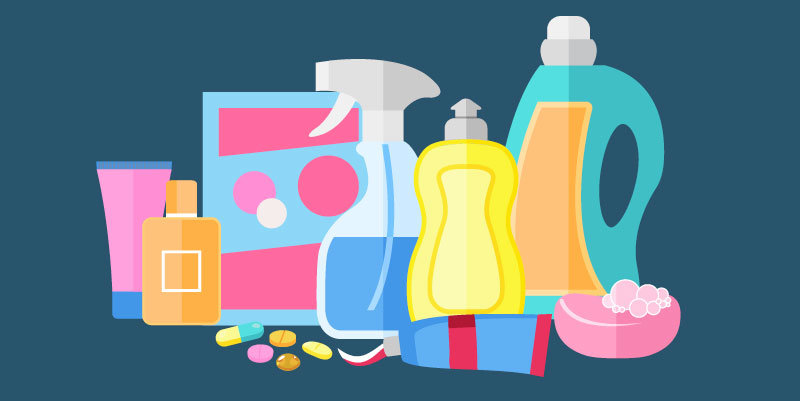
“The dose makes the poison.” – Paracelsus
Pretty Poisons
We all know we must keep the bleach locked away from the kids. We care about safety, and bleach looks and feels like poison. But what if the bleach looked like candy? Or what if the poison didn’t seem like a poison, but like a beauty product, vitamin or even toothpaste?
It’s become a habit of packaging to make poisons pretty, whether that’s colouring glass cleaner bright blue or designing laundry pods that look like gummy candy. Young kids don’t read labels, and, in their world, bright beautiful things are made for them, and are usually delicious.
Every day, hundreds of children across Canada and the US are hospitalized as a result of poisoning themselves with common products that are often left within reach and unprotected. In the past couple of years, emergency rooms have seen a troubling spike of kids, including teenagers, who ingest cleaning products, detergents, and other toxins.
The Toxic Six:
Here are the household poisons that give poison centres the most calls:
- Laundry Detergent packs: Bright and beautiful, these laundry and dish detergent pods look eerily similar to candy. But the substances inside can be deadly. In order to make a small pod, the chemicals are concentrated. Keep them childproofed at all times, and wash your hands after handling. Every year, thousands of kids in Canada and the US are rushed to hospital due to breathing problems caused by ingestion.
- Dishwashing Detergent Pods: Like laundry pods, these are brightly coloured to look like taffy or gummy candy. They’re also commonly kept under the kitchen sink, which is in the highest traffic room of the house and at a toddler’s level. Most poisonings from these are in kids under 3; childproof locks are a must. Note: watch your kid with the lock, as some toddlers can easily open them. If they can, get a more complicated lock.
- Toothpaste: It’s probably surprising, but fluoride toothpaste is toxic in high doses. Keep the toothpaste tube out of reach, supervise brushing, and train your kiddo not to swallow the toothpaste. Kids aged 2-6 should have a pea-sized amount, only.
- Lotions and Creams: Kids love to apply lotions to be beautiful like Mommy, but if that delicious smelling, colourful lotion ends up in their mouths it could turn dangerous. Put your lotions away after use.
- Vitamins: It’s a bit ridiculous how delicious they make kids’ vitamins. One a day is excellent, but too many can be harmful. Keep them out of reach and don’t give in to the “more, pleases.”
- All-Purpose Cleaners: Why does my window cleaner look like Gatorade? It may be good marketing, but through a child’s eyes, which are on a constant hunt for juice, they can look irresistible. Cleaners are one of the most commonly ingested toxins, so keep the them out of reach and/or locked up.
Other things to watch: It’s quite a list. You don’t need to lock these all away, but keep an eye on them. Tiny amounts are rarely dangerous, but stay wary:
- Cosmetics
- Perfume
- Mouthwash
- Hair Dye
What to Do in Case of Poisoning:
If you think your child has ingested poison, call Poison Control immediately. Remain calm, but the sooner you take action, the better the outcome is likely to be.
The Canadian Association of Poison Control Centres’ website is: http://www.capcc.ca/. Find your provincial number from the drop-down menu at the top and put it on the fridge. Add it to your phone contacts as well, under a name you’ll remember in a crisis (like “POISON”).
Get the substance out of reach of the child. It sounds obvious but in a crisis we can miss the obvious.
Your kid needs to spit it out. Then, making sure there’s none of the substance on your fingers, physically check their mouths. Keep a sample of the substance and the container, if possible, as this will save time.
Do not make your child vomit. This is a myth and it can do more harm than good.
If your child is unconscious, not breathing, or having convulsions or seizures, call 911 right away. Alternatively, call your Poison Control number. Stay calm; the last thing the Operator needs to be doing is calming you down to get the answers he or she needs.
http://www.ncpoisoncenter.org/body.cfm?id=276
http://www.grandparents.com/grandkids/safety/hazardous-household-products
http://www.poison.org/common-and-dangerous-poisons
http://health care.utah.edu/healthfeed/postings/2015/03/032015_slideshow-household-poison.php
http://kidshealth.org/en/parents/safety-poisoning.html